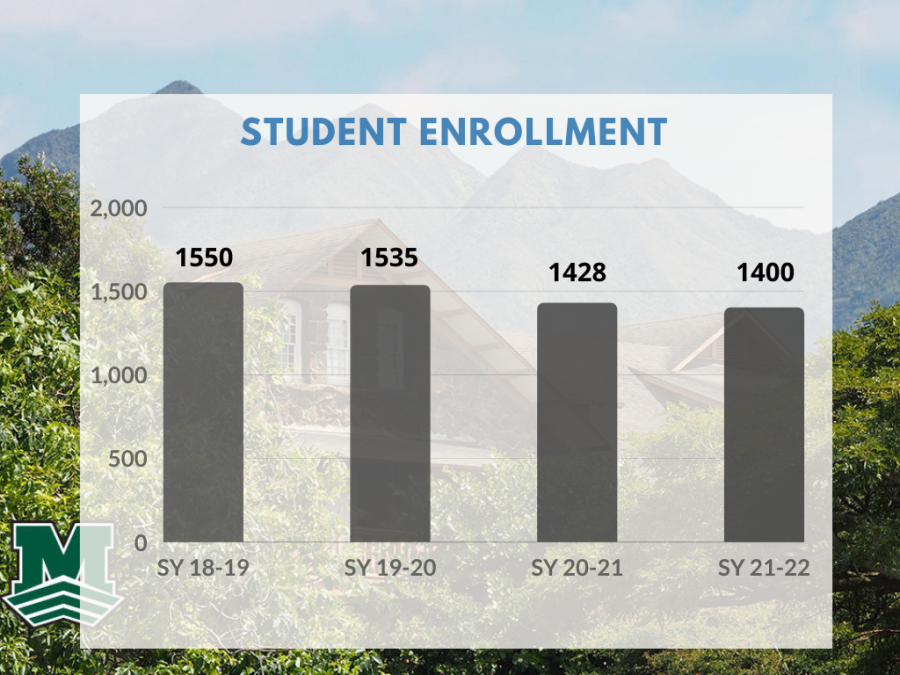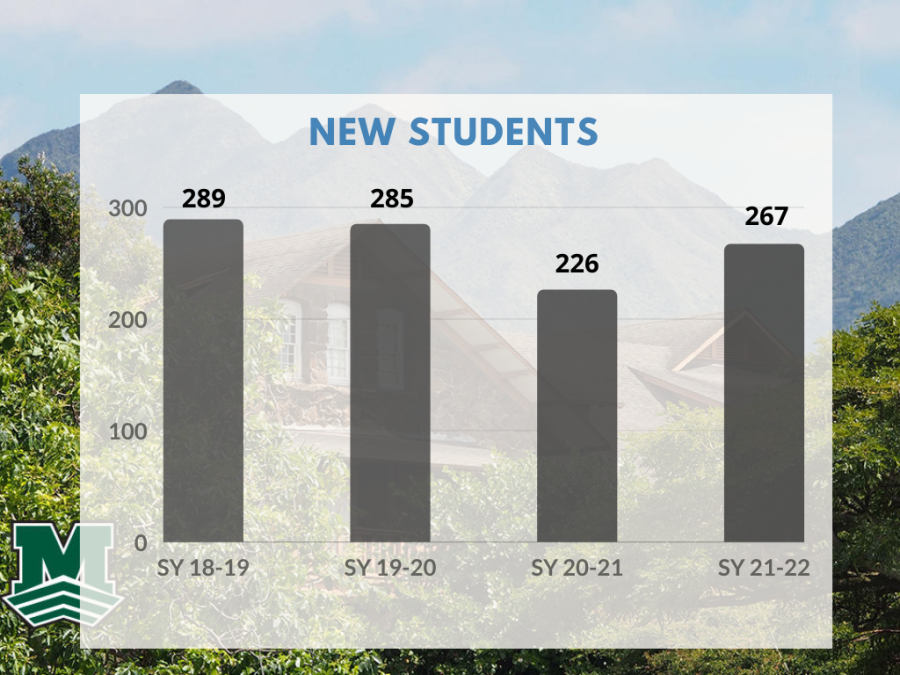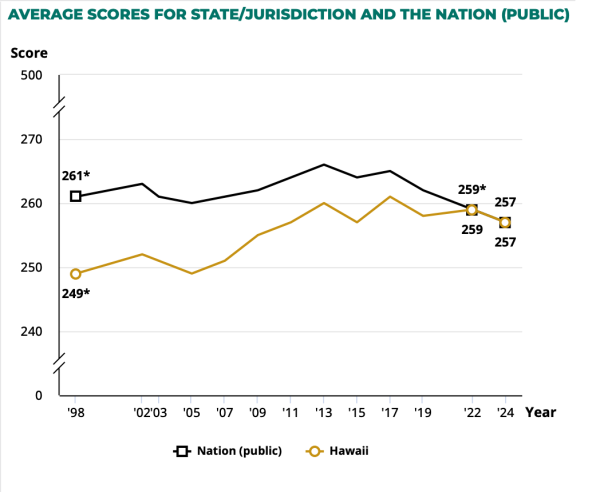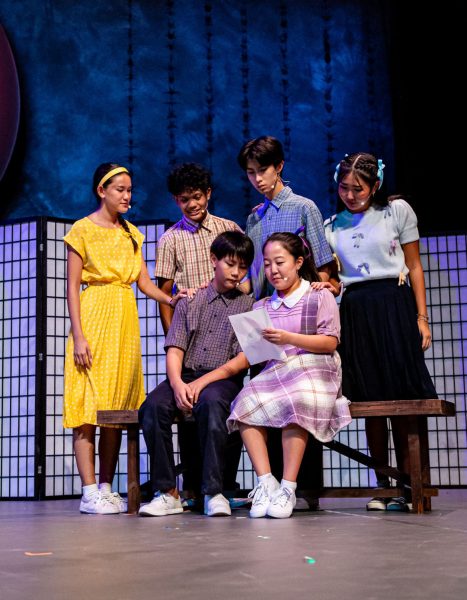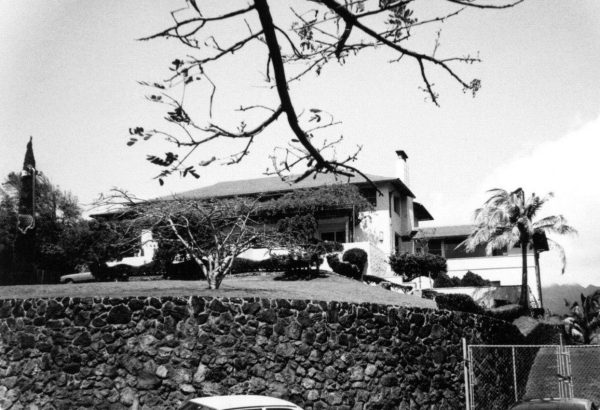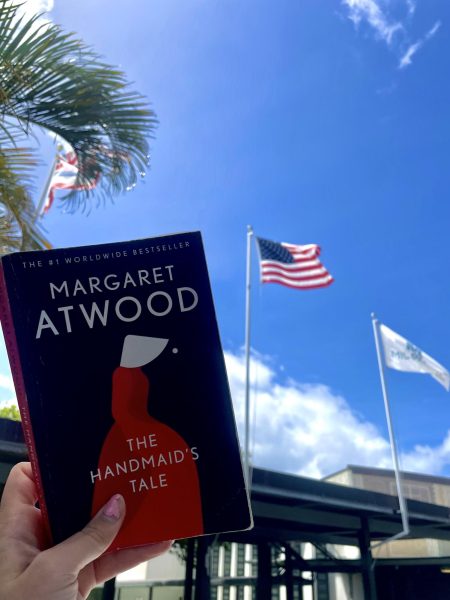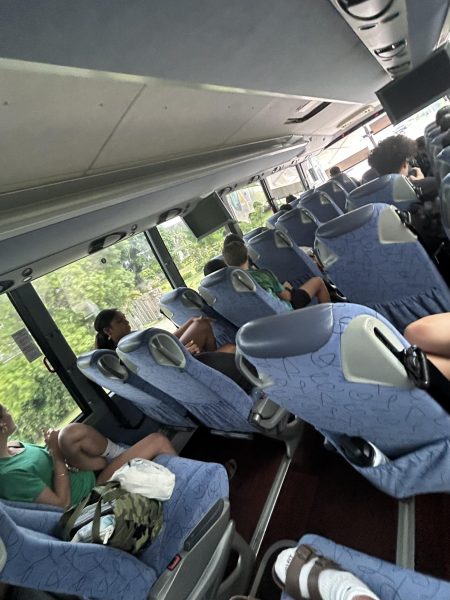Mid-Pacific enrollment is down, but not in the way you’re thinking
Bar chart shows the numbers of student enrollment from academic year 2018 to 2021.
By Chelsee Sawai
Staff Writer
Mid-Pacific’s enrollment continued its down trend from the beginning of last school year in 2020, but reported data gives signs of hope for a rejuvenated road to recovery.
During the 2019-2020 school year, 1,535 students enrolled at Mid-Pacific. However, enrollment decreased by seven percent in the following school year of 2020-2021. 107 students didn’t return amid COVID-19’s surge in Hawaii.
This school year, 1,400 students showed up on the first day of school, which is an eight percent decrease in student enrollment from two years ago.
“When we planned for [the] school year 2021-2022, we planned that our enrollment would be between 1,375 and 1,400,” said Vice President of Academic Affairs Leigh Fitzgerald.
According to the National Center for Educational Statistics, the nationwide count of reported students enrolled in public schools in the United States for the 2020-2021 school year declined by three percent from the 2019-2020 school year.
Mid-Pacific’s downward enrollment follows a similar trend.
“We assume we’ll be down about another 50 kids next year,” said Fitzgerald. “Enrollment will settle at about 1,350 students for the whole school as we move forward.”
Mid-Pacific’s attrition rate, the number of students who left, showed a loss of 5.8 percent of students from last year, but the school gained a total of 267 new students out of the 534 students that were offered admission from the 807 total applications this year.
Already, 370 applications for next year have rolled in, many for the elementary school since there are limited spots. The application deadline is Dec. 1.
“The enrollment decrease has occurred because people unfortunately were not able to afford private education or they are making different choices for their family right now. However, we actually have more applications already at this point for next year than we have in the past 5 years, which is great,” said Fitzgerald.
In addition to regular enrollment, English Language Development enrollment has suffered a significant enrollment loss since the 2018-2019 school year, going from 80 students to 60 students this school year, a 25 percent decrease within the past three years.
Assistant Director of International Enrollment Kate Blackburn said this trend is due to factors stemming from COVID-19.
“In the past year, due to COVID reasons and government restrictions and travel restrictions, we just saw that our applications were much lower, which meant that our matriculation is lower based on the numbers,” she said.
Locations that ELD students come from to study at Mid-Pacific are Japan, South Korea, China, Vietnam, Germany, Taiwan, Russia, United Kingdom, Australia, New Zealand, Switzerland, Mexico and Hong Kong. These countries have since been limited to representation within the international student population due to the enrollment halt.
Additionally, Mid-Pacific’s tuition rose $671 from last year, with tuition currently at $27,511. Many families struggle with not only the tuition increase, but the entire cost of education, including lunch, books and other additional financial commitments.
“It was not nominal as it was to previous years in a way that actually should have been able to be made up in financial aid if it was going to be a significant impact to any family,” Fitzgerald said.
Although tuition increased, student aid also increased with five million dollars awarded for the 2021-2022 school year, which means a 30 percent financial aid rate and an average of $10,625 per student awarded.
“I’ve heard from a lot of my friends that it [the cost of tuition] is an issue and they’ve asked me how to get financial support or if I know of any scholarships,” said sophomore Sydney Woolley. “This is just with my friends so if we look at the whole student body, I’m sure there would be a lot more.”
Statistics show consistency in Mid-Pacific’s effort to provide financial aid to students in the last four years. This year, 29 percent of students received aid towards their tuition. On average, financial aid to students has appeared steady at around 30 percent.
“We were able to offer a bit more financial aid last year because of the Owl Strong Response Fund, but that was a one year fund so that’s where we saw that spike up to 33 percent,” said Fitzgerald. “Whereas usually, we’re right around 29-30 percent when you look historically at students receiving financial aid. But the school does its very best to award the families a maximum amount of financial aid each year.”
Despite tuition and enrollment challenges, new students entered campus with warm smiles and welcome from the Mid-Pacific community.
“I feel very welcomed and my homeroom, they’re super nice. All the girls came up to me at first and asked me how I’m liking everything so far and they always say hi to me when I’m walking to my classes,” said new student and senior Jacie Nava.
However, junior Tyrael Goo said they feel like the student community can do better in being inclusive to new students and instead of remaining friendly only with familiar faces.
“I feel like there’s a disconnect between the students who have come in the past 2 years and the students that came before that because they had time to establish connections and relationships with people,” said Goo.
Wooley said she hasn’t seen many new students and connected it to the downward enrollment and the pandemic as a whole.
“I do like to talk to new kids, but I haven’t met any new kids and I just thought that was because not a lot of kids move [transfer] in high school, but I guess it’s because not a lot of people are enrolling,” she said.
According to a news update by Governor David Ige, the Department of Business, Economic Development and Tourism’s economic growth projection for 2021 in Hawaii was estimated to be 2.7 percent, down from the 3.5 percent projected this past May. Mid-Pacific follows the economic trends affecting the state as the school suffered this year in enrollment, which brought in less money and made it difficult to prevent the elimination of classes for students currently attending.
Fitzgerald said Mid-Pacific is trying to provide as many opportunities for students this school year as possible while also evaluating the budget at hand.
“We’re looking at where we have spent money in the past outside of the direct student program that we could cut back on, so that there’s less impact on the students’ programs itself,” she said. “We still want to be able to offer all of the programs and classes that you all came in to take so it does get tricky and we have to make cuts in certain places because we want to be able to offer all classes.”

